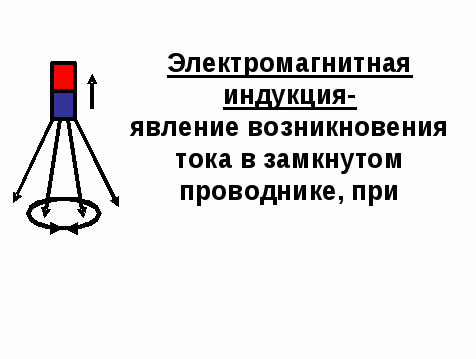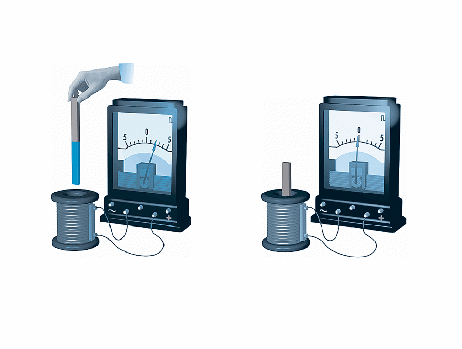Physics lesson in grade 9 on the topic "Electromagnetic induction".
Physics teacher Misharina T.V. "Gymnasium No. 1", Syktyvkar.
Lesson Objectives:
Educational: to study the physical features of the phenomenon of electromagnetic induction, to form the concepts: electromagnetic induction, induction current.
Developing: to form in students the ability to highlight the main and essential in the material presented in different ways, conduct observation and experiment;
development of cognitive interests and abilities of schoolchildren in identifying the essence of processes .
Educational: to cultivate diligence, accuracy and clarity in the answer, the ability to conduct a dialogue, the ability to work in a group, ask questions necessary for organizing their own activities and cooperation with a partner, exercise mutual control and provide necessary mutual assistance in cooperation.
Equipment:
Computer, multimedia projector, bar magnets; galvanometers, milliammeters, coils from a collapsible model of an electromagnet, current source, connecting wires.
1. Organizational moment. We continue to study magnetic phenomena. Before moving on to a new topic, let's review what we studied earlier and what will be useful to us today in the lesson.
2. Repetition and control of knowledge
- (a written task, after which students perform a self-test, is shown on slide 1) Finish the phrases:
1. The magnetic flux is calculated by the formula: Ф = ...
and measured in...
2. Visually F - ...
3. Ф depends on: 1 ... 2 ... 3 ....
- (Orally analyze the question from 2 slides)
- (we repeat, what is an electric current and how to create a magnetic field?)
3. Explanation of new material.
(I ask students to recall Oersted's experience, explain it, what was found in it?)
What inverse problem can be made using Oersted's experiment?
Is it possible to solve this problem, we will find out today in the lesson, studying the phenomenon of electromagnetic induction. The discovery, which was recognized as the greatest achievement of the 19th century. (The topic of the lesson appears on the slide) Why is this so we will try to find out in this or the next lesson. In Oersted's experiment, an electric current created a magnetic field. Is it possible to generate current using a magnetic field? Many scientists tried to solve this problem in the 19th century. The English scientist Michael Faraday put it in front of him: "Turn magnetism into electricity." It took him 10 years to solve it. (record appears on the slide).
Before you on the tables is a biography of Faraday, read it. (Students read and think about the text)
What interesting things did you learn about the scientist? (student answers)
We will discover with you what Faraday could not discover for 10 years in a few minutes. What devices do I use? Why is the circuit closed, but there is no current? (I demonstrate the experience and its animation model on the slide)

At what point does he appear? Why did the induction current appear, which is no different from the current created by the source?
(demonstrating the animation of the experience on the slide) What do you see on the screen? What needs to be done to get current? What does this change in the magnetic field?
(students guess that for the appearance of current, the magnetic flux must change).

Try to formulate the phenomenon of electromagnetic induction.
Find the definition on page 165 and complete the definition of the phenomenon of electromagnetic induction. (Students' answers are heard, and a record appears on the slide)
 (I demonstrate this slide and tell, demonstrating Colladon's experience)
(I demonstrate this slide and tell, demonstrating Colladon's experience)
Why did Colladon not discover the phenomenon of electromagnetic induction? (Students answer)
Exploring patterns
Empirically, we will find out the features of the phenomenon of electromagnetic induction. Each group will receive a task to complete and explain to the class what the experience (demonstrate) was that you conducted and what conclusions you came to. You have 7 minutes to complete the task.
- group assignments:
1. Do the experiment shown in Figure 126 a p. 163. Draw a conclusion about when the induction current occurs in this experiment and what happens to its direction?
3. Do an experiment, with the proposed devices, similar to the one shown in Figure 127, page 164. with two coils. Make a conclusion about when the induction current occurs in this experiment and what happens to its direction?
4. Do an experiment similar to those shown in Figure 128 a, b p. 165. Draw a conclusion about when the induction current occurs in this experiment and what happens to its direction?
5. Do the experiment shown in Figure 126 a. p. 163. draw a conclusion about what happens to the magnitude of the induction current when the magnet moves slowly and quickly.
What happens to the magnetic flux penetrating the coil as the magnet approaches and moves away?
(after conducting the experiments, the groups, in turn, talk about how they were carried out and what conclusions they made)
Primary consolidation of the studied material
What can be found in common in all the experiments conducted by you?
What determines the direction of the induced current?
What determines the magnitude of the induced current?
(based on the analysis of the students' answers, conclusions are drawn that appear on the slide)

4. Homework.
Describe the method of obtaining the induction current that you like the most.§49.
5. Summing up the training session
On the cards, write down the composition of the group and evaluate the work of each.
Have we solved the problem: to get current using a magnetic field?
Why the discovery of electromagnetic induction was recognized as the greatest achievement of the 19th century?
Conduct a self-assessment of your own performance in class. Fill the table.
Literature
1. Peryshkin A.V., Gutnik E.M. "Physics - Grade 9", Moscow "Business Bustard", 2011
2. Diaghilev F.M. From the history of physics and the life of its creators, Moscow "Enlightenment", 1986
3. Volkov V.A. Lesson developments in physics Grade 9, Moscow “Vako”, 2009
Applications:
Handout:
Biography of M. Faraday
He did not receive a secondary education, he was self-taught.
Corresponded with Charles Dickens, was actively interested in literature and theater.
Faraday's talisman was a magnet, which he carried in his pocket for many years.
Honorary member of 72 scientific societies.
Almost until his death, he read public lectures, refusing to cancel them even with an exacerbation of the disease.
Michael Faraday was born on September 22, 1791 in Newngton Butts, near London. His father was an ordinary blacksmith from the suburbs. Both father and mother supported their son, who from a young age showed a craving for knowledge, helped him financially. The latter was especially important for the family, since the Faradays lived poorly.
At the age of 13, Michael is forced to leave high school. The family is simply not able to support him, and the young son of a blacksmith goes to work. At first, he delivers newspapers and books, and at the age of 14 he became an apprentice in a bookstore. Here Michael mastered the work of a bookbinder well. In total, Faraday worked in the bookbinding workshop for 7 years. All this time he is engaged in self-education. He works hard, giving it all his free time. Michael's favorite sciences are chemistry and physics. He equips a home laboratory in which he sets up experiments, manufactures electrostatic devices. Then he visits the City Philosophical Society, takes part in debates on physics and astronomy.
In 1812, an insignificant event occurred that became a turning point in Faraday's life. One of the workshop's clients gave the young bookbinder tickets to the lecture evenings of Humphry Davy, who spoke at the Royal Institution. Having visited Davy's lectures several times, Michael sends him a letter asking him to accept him at the Royal Institute for a job. Davy was amazed by the knowledge of the young man, but there were no open vacancies at the institute at that time. Michael had to wait a few months, and then he took up the duties of a laboratory assistant in the chemical laboratory at the institute. Shortly thereafter, Davy, who goes on a trip to Europe with his wife, takes Faraday with him. During this journey, Michael met Gay-Lussac, Ampère, Volta and some other prominent scientists of that time.
In 1815, at the end of the journey, Faraday began to work very actively, focusing on independent scientific research. The very next year, at the Society for Self-Education, Michael begins to read a course of lectures in chemistry and physics.
In 1821, Faraday created the first model of an electric motor. Over the next decade, the scientist explores the relationship between magnetic phenomena and electricity. In 1824, Michael was elected a Fellow of the Royal Society.
In 1831, as a result of many years of work, Faraday discovered the phenomenon of electromagnetic induction. Soon the scientist derives the basic laws of the phenomenon. Today, all alternating and direct current generators work precisely thanks to the discoveries of Faraday.
Tasks for groups.
1. Do the experiment shown in Figure 126 a p. 163. Draw a conclusion about when the induction current occurs in this experiment and what happens to its direction? (You can use the text of the textbook).
What happens to the magnetic flux penetrating the coil as the magnet approaches and moves away?
2. Do the experiment shown in Figure 126 b p. 163. Draw a conclusion about when the induction current occurs in this experiment and what happens to its direction?
(You can use the text of the textbook).
What happens to the magnetic flux penetrating the coil as it approaches the magnet and moves away?
3. Do an experiment similar to that shown in figure 127 p. 164 with two coils, using the instruments available on your table. Make a conclusion about when the induction current occurs in this experiment and what happens to its direction? (You can use the text of the textbook).
What happens to the magnetic flux penetrating the coil connected to the galvanometer when the second coil is closed and opened, the current in it changes and moves?
4. Do an experiment similar to those shown in Figure 128 a, b p. 165. Draw a conclusion about when the induction current occurs in this experiment and what happens to its direction? (You can use the text of the textbook).
What happens to the magnetic flux penetrating the coil when the magnet rotates?
5. Do the experiment shown in Figure 126 a. p. 163 draw a conclusion about what happens to the magnitude of the induction current when the magnet moves slowly and quickly.
What happens to the magnetic flux penetrating the coil as the magnet approaches and moves away?
